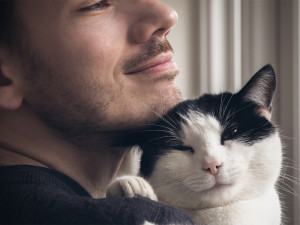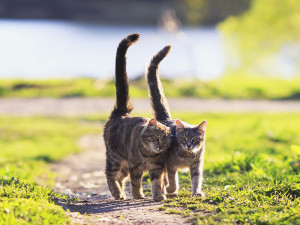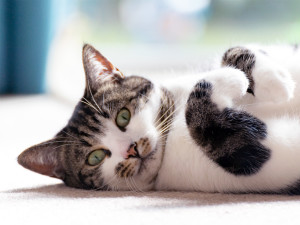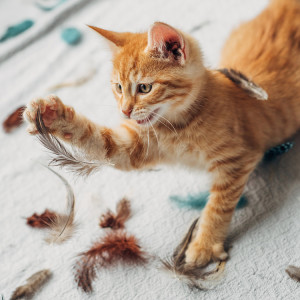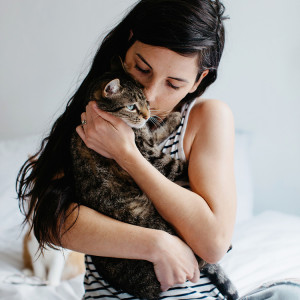Cat Trilling: What Does it Mean and Why Do Cats Do It?
Add this unusual sound to your feline-to-English dictionary

Share Article
Have you ever heard your cat make a short, soft, rolling, high-pitched chirp? It’s not quite a meow, not quite a purr, but something in between. It’s called trilling and it’s a special form of cat communication. The best part? It’s usually used to show contentment or affection. So if your cat trills as a greeting, you can take that as their way of saying, ‘I’m glad to see you!’
Why do cats trill?
“Trilling is a vocalisation that involves the movement of the mouth and vocal cords in a way that’s unique to cats,” explains trainee animal behaviourist Lottie Phillips. “It’s a form of communication expressing a variety of feelings or desires, including saying hello, asking for attention or displaying contentment,” says Lottie, who explains that a trill is usually a positive declaration. But cats can trill for several reasons and understanding the context can help you figure out what your cat is trying to communicate.

littleKin™ is Kinship’s home just for puppy and kitten parents. Bop over to check out expert advice, new pet tools, and special deals—all curated for your newest family member.
opens in a new tabExpressing happiness: “much like a cat’s purropens in a new tab, headbuttingopens in a new tab, slowing blinkingopens in a new tab or rubbing against your legs, trilling can often signal that your cat is expressing warmth and pleasure towards you,” says Lottie.
Seeking attention or reminding you it’s dinnertime: cats also trill when they want your attention (which includes feeding). Using this method of communication shows they’re comfortable expressing their needs to you.
A desire to play or explore: a trill is also a way for cats to express their playful nature and it could be an invitation to play with themopens in a new tab.
Kitten communication: mother cats also use trilling as a nurturing sound to communicate with their kittens, guiding them or calling them back to safety.
How to respond when your cat trills
Cat parents can become quite well versed in cat communication over time and it’s easy to learn how to decipher what your cat wants if you pay attention to the context and behaviour – and trilling is no different.
“If your cat trills when you walk in the door, it’s a hello and they probably want you to stroke them and act excited to see them in return. If they trill while standing near their food bowl, it could mean ‘feed me’. If the trill is accompanied by affectionate rubbing against you and their tail is standing up straight, it’s a warm gesture and you can respond by stroking them. If your cat’s tail is slowly swishing left and right while they trill then it could be a sign they want to play, so get the toys out,” says Lottie. So take your cues from the context and respond appropriately!
Other ways cats communicate
Cats have a wide range of communication tools, which is made up of body language, sounds and ‘tail talk’.
Purring
Cats often purropens in a new tab when they are completely content or being stroked. But they also purr at other times: there are cats who purr when exploring an unfamiliar area and cats who purr when they’re eating. Purring can be triggered by traumatic movements, by injury or by hunger. There are cats who purr when they’re greeting a friend and cats who purr when they’re anxious.
Headbutting
“Headbuttingopens in a new tab is one of the ways cats show affection,” says New York-based cat behaviour consultant Jennifer Van de Kieftopens in a new tab. “My cats do it to each other, often. If they rub their cheek on you in the process, they may be marking you. Take it as a huge compliment.” It can also be a sign of trust, to get your attention and to express dominance. Occasionally it can mean they are in pain or something is off – so again, pay close attention to the context.
Licking
“If your cat likes to lick youopens in a new tab, this could also be for a number of reasons, from showing you love by ‘grooming’ you to scent marking you as ‘their property’,” explains Lottie.
Slow blinking
Is there any bigger honour than a cat slow blinkingopens in a new tab at you? “Cats slow blink to express love, trust and affection,” says Lottie. Think of the slow blink as the feline version of a gentle, welcoming smile. It’s also one of the few ways that we, as humans, can communicate back with cats in their own language. So the next time your cat slow blinks at you, do it in return to strengthen your bond.
Tail talk
“Your cat’s tail is actually one of their key communication tools,” says Lottie. Their tail position and movement can convey a huge range of emotions and intentions, including anger, happiness and discomfort. If you learn all the meaningsopens in a new tab, you’ll be able to understand your cat so much better.
Other forms of communication
Cats also lift their pawsopens in a new tab, hissopens in a new tab, chatteropens in a new tab, follow youopens in a new tab around the house, sleep on youopens in a new tab, biteopens in a new tab, stareopens in a new tab, kneadopens in a new tab and have many other ways of showing affectionopens in a new tab, so it’s important to familiarise yourself with all different kinds of cat communication so you can respond to your cat’s needs and create a two-way dialogue.
But the bottom line is, if you have a cat who trills, you are probably very much loved by your feline companion.
Ro Elfberg
Ro is Kinship UK’s Senior Editor. She has previously written and copy-edited for British Vogue, Glamour and DICE. When she’s not being manipulated into dishing out Dreamies to Kobe the cat, she spends her free time trying to convince her snake, Butters, to wear a tiny hat.
Related articles
![Two cats walking with their tails sticking straight up]() opens in a new tab
opens in a new tabTail Talk: What Is Your Cat Trying to Tell You?
Cats are enigmas. But their tail movements can reveal a lot about their moods
![A kitten and a puppy laying on the floor looking at each other.]() opens in a new tab
opens in a new tabHow Dogs and Cats Communicate With Each Other
There might be a language barrier, but these two animals can still become best buds
![tri-colour, calico cat, white, black and tabby cat lying on their back with their paws lifted, looking at the camera]() opens in a new tab
opens in a new tab10 Common Cat Myths (That Are Actually False)
Peel back the layers of mystery to discover the truth about our feline friends
![A cute orange tabby kitten playing with feathers.]() opens in a new tab
opens in a new tabIs ‘Orange Cat Behaviour’ Real?
Your TikTok algorithm would like you to think so, but the experts weigh in
![dark-haired woman hugging cat that has imprinted on her]() opens in a new tab
opens in a new tab10 Signs Your Cat Has Imprinted On You
Feeling like you have a little shadow these days? A cat behaviourist explains why that’s happening
![a tattooed person with curly red hair on a couch pets a brown and black cat]() opens in a new tab
opens in a new tabCan Your Cat Smell If You’re Stressed?
And will they do anything about it if they do?
